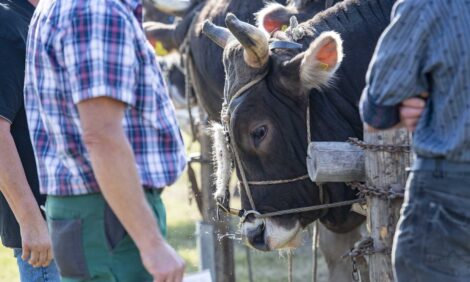



Effects of Age and Method of Castration on Performance and Stress Response of Beef Cattle
Prepared by Hajiba Zaaboul, Ag-Info Centre, Alberta Agriculture and Food.Why is it so important to evaluate the effects of age and method of castration?
The main reasons calves are castrated are to reduce meat toughness, remove aggressive behavior and dark cutters. The process of castration is very stressful on beef cattle and leads also to a weight loss. Effect of castration on performance is independent of the breed and feeding systems. However, the age and method of castration have an important impact on growth performance and stress response of beef cattle. So, it is important to be aware of those consequences in order to choose the right age and the safer method.How does age of castration affect performance and stress response?
During puberty, the testes primarily produce androgens that promote muscular development by increasing nitrogen retention. This does not occur until calves are 9-10 months old. After castration, calves start loosing weight and their average daily gain drops for a period. Castration at birth or close to birth reduces drastically the weight loss and associated stress. Contrary to common ideas, scientific studies have showed that calves castrated at birth reach weaning at the same live weight as calves castrated at weaning because the productivity differences due to testosterone are manifested after puberty (3-4 months after weaning). Moreover, by the time of beginning the fattening period as steers, calves castrated at birth will have a better corporal condition. So, it is better to castrate calves at birth or a short period after birth for all the reasons listed above and also because they are small, easy to handle and recovery is quicker. In term of stress response, it is lower in case of cattle castrated at an age less than 6 months indicating that when calves are castrated younger, they suffer less stress probably because of the discomfort caused as the testicular size increases (especially under 6 months age).What happens when bulls are castrated at older ages?
In many productive systems, calves are castrated between 6 and 9 months of age at weaning; one of the most stressful managerial conditions for calves. However, the younger a calf is castrated, the less stressful is the procedure. Therefore, it's suggested that an earlier castration may reduce the stress, improve the animal welfare by reducing the castration-associated trauma and also the weaning associated stress. Studies found that cattle castrated post-puberty extend the weight loss for 4.5 months. This important weight loss would be associated in part with a less average daily feed intake but principally with an apoptotic process in the main testosterone-responsive muscle regions (particularly neck and shoulder), which would be triggered by testosterone withdrawal.What about the method of castration?
Most common methods for castrating males are surgical and rubber banding. For plasma cortisol concentration as a measure of stress response, there is no significant difference between surgically castrated and banded cattle. However, levels of Haptoglobin- a serum protein that can be used to quantify the discomfort of animals- were higher for surgical procedure. Rubber banding may be, if done appropriately less stressful and safer for young calves particularly because surgical castration is often associated with severe complications such as infections and hemorrhages.Is it advisable to use rubber banding on bulls 1-year or older?
Despite that average daily gain was not affected by the technique of castration employed, rubber banding is not advisable to use for post pubertal cattle because their developed genital organs may affect its precise application and result on some wounds.When is the best time to castrate calves?
Considering the productive disadvantage of delaying castration beyond birth and the safer and less laborious that is the rubber banding castration, it is recommended that castration occur at or shortly after birth with the rubber band. Castration after puberty is not suggested because cattle loose the advantage of anabolic testosterone properties they gained before being castrated.Reference article: Bretschneinder, G. 2005. Effects of age and method of castration on performance and stress response of beef male cattle. Liv.Prod. Sci. 97, 89-100
February 2007


